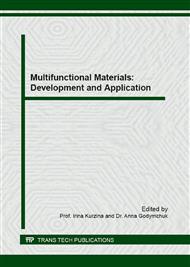p.569
p.576
p.583
p.589
p.596
p.601
p.609
p.617
p.626
Classification of Natural and Thermo-Modified Peat by Class-Modeling Techniques
Abstract:
Significant attention is paid to the production of peat-based materials in modern days. The study explores the influence of natural peat thermal modification on its properties by applying class-modeling techniques. Modification of different types of peat is achieved by heating at 250 °C. The set of peat properties such as component composition, g-factor and IR-spectra is used to obtain data matrix. It is shown that class-modeling techniques, such as partial least-squares discriminant analysis (PLS-DA) and simple independent modeling of class analogy (SIMCA), allow estimating peat class (natural or modified) by a set of properties without prediction errors by using three latent variables. According to the results of classification, it is established that thermal modification can be considered as a means of regulating the composition and physico-chemical properties of natural peats as a raw material
Info:
Periodical:
Pages:
596-600
Citation:
Online since:
February 2016
Authors:
Keywords:
Price:
Сopyright:
© 2016 Trans Tech Publications Ltd. All Rights Reserved
Share:
Citation:


